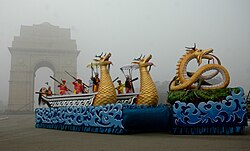Meitei mythology
Meitei mythology or Manipuri mythology is a body of traditional legendary myths pertaining to the origin and the religious systems of Ancient Manipur (Antique Kangleipak), generally retold by the Meitei ethnicity.[1][2][3][4]
Meitei mythology may also refer to the modern analysis of the representation of the Meitei literature and art of the Meitei culture of the Meitei people.[3] The Meiteis usually treated their mythology as history even though it includes supernatural or mythical or miraculous elements.[1][2]
Source texts[edit | edit source]

There are sources from both the manuscript as well as oral folklore in Antique Kangleipak (Ancient Manipur). The so-called manuscripts are known as Puya (Meitei texts), which are the original accounts on the religious themes as well as historical events of the Meitei literature. Wakoklon Heelel Thilen Salai Amailon Pukok Puya, Sanamahi Laihui and Numit Kappa the most prestigious Puya (Meitei texts) in the Meitei mythology.
Deities[edit | edit source]
The Meitei deities, are always associated with the Meitei religion, which has been in existence since ancient times in the Kanglei World. The traditional culture and folklore is inherited by the Meitei people from their primitive ancestors till present.

The primordial deities in the mythology and religion are:
- Sidaba Mapu: He is the Creator God of the entire universe, and the sole breeder of all the living beings.[5]
- Sanamahi: He is the Guardian God of the mankind and the household. He created the human beings in the figure of the Almighty.[6]
- Pakhangba: He is the destroyer and the ruler of the universe. He can assume both human as well as serpentine figure.[7]
- Leimarel Sidabi: She is the supreme mother earth goddess and the consort of the creator God.[8]
- Emoinu (Imoinu): She is the goddess of wealth and prosperity. Legend says she's an exact copy of Leimarel, who takes another divine form.
In addition to these, the mythology also accounts for the vast numbers of deities as well as mythical creatures. The Lists of creatures in Meitei Folklore are found in the vast narratives of both the PuYas as well as Meitei folklore.
Creation myths[edit | edit source]
According to the Meitei mythology (Manipuri mythology), it is Lord Pakhangba, the Great Dragon Lord, who gave birth to the seven clans of the Kanglei realm (Antique Kangleipak).[7] The seven clans are
| Clan names | Romanization |
|---|---|
| ꯃꯉꯥꯡ | Mangang |
| ꯂꯨꯋꯥꯡ | Luwang |
| ꯈꯨꯃꯟ | Khuman |
| ꯑꯉꯣꯝ | Angom |
| ꯃꯣꯢꯂꯥꯡ | Moilang |
| ꯈꯥ ꯉꯥꯟꯄ | Kha Nganpa |
| ꯁꯂꯥꯢ ꯂꯩꯁꯥꯡꯊꯦꯝ | Salai Leishangthem |
Incarnations[edit | edit source]
The legendary epic tales of the seven incarnations of a God and a Goddess, in the ancient kingdom of Moirang, are the main features of the Kanglei mythology (Meitei mythology), with the Khamba Thoibi incarnation, being the last and the most significant one. The very incarnations of the Lord and the Lady respectively are as follows:
| Male characters | Romanization | Female characters | Romanization |
|---|---|---|---|
| ꯑꯀꯣꯡꯖꯥꯝꯕ | Akongjamba | ꯐꯧꯑꯣꯢꯕꯤ | Phouoibi |
| ꯍꯦꯟꯖꯨꯅꯍꯥ | Henjunaha | ꯂꯥꯢꯔꯧꯂꯦꯝꯕꯤ | Lairoulembi |
| ꯈꯨꯌꯣꯜ ꯍꯥꯎꯕ | Khuyol Haoba | ꯌꯥꯢꯊꯤꯡ ꯀꯣꯅꯨ | Yaithing Konu |
| ꯀꯗꯦꯡ ꯊꯥꯡꯖꯍꯟꯕ | Kadeng Thangjahanba | ꯇꯣꯅꯨ ꯂꯥꯢꯖꯤꯡꯂꯦꯝꯕꯤ | Tonu Laijinglembi |
| ꯈꯨꯕꯣꯝꯕ | Khubomba | ꯄꯤꯗꯣꯅꯨ | Pidonu |
| ꯋꯥꯡꯂꯦꯟ ꯄꯨꯡꯇꯤꯡꯍꯩꯕ | Wanglei Pudingheiba | ꯁꯥꯞꯄ ꯆꯅꯨ ꯁꯤꯜꯍꯩꯕꯤ | Sappa Chanu Silheibi |
| ꯈꯨꯃꯟ ꯈꯝꯕ | Khuman Khamba | ꯃꯣꯢꯔꯥꯡ ꯊꯣꯢꯕꯤ | Moirang Thoibi |
References[edit | edit source]
- ↑ 1.0 1.1 https://books.google.co.in/books?id=_HmwAAAAIAAJ&q=meitei+myth&dq=meitei+myth&hl=en&sa=X&ved=2ahUKEwjYtJbYvuLuAhX17HMBHe9CBhgQ6AEwCXoECAkQAg
- ↑ 2.0 2.1 https://books.google.co.in/books?id=p1cOAAAAIAAJ&dq=meitei+myth&focus=searchwithinvolume&q=Manipuri+myths
- ↑ 3.0 3.1 https://books.google.co.in/books?id=AoECgkZ0Wu0C&q=meitei+mythology&dq=meitei+mythology&hl=en&sa=X&ved=2ahUKEwiLydm4vuLuAhUOgdgFHaKKAmc4ChDoATAHegQIAhAC
- ↑ https://books.google.co.in/books?id=WEQqAAAAYAAJ&q=manipuri+mythology&dq=manipuri+mythology&hl=en&sa=X&ved=2ahUKEwiN_MrEp_XuAhXVlEsFHYlvAukQ6AEwBHoECAYQAw
- ↑ "The Manipuri Lais". manipuri.itgo.com. Retrieved Mar 1, 2021.
- ↑ http://manipuri.itgo.com/the_lais.html#sanamahi
- ↑ 7.0 7.1 "The Manipuri Lais". manipuri.itgo.com. Retrieved Mar 1, 2021.
- ↑ "The Manipuri Lais". manipuri.itgo.com. Retrieved Mar 1, 2021.
External links[edit | edit source]
- https://www.lapolo.in/blog/manipuri-mythology-polo/
- http://www.apamnapat.com/entities/Chitrangada.html
- https://papers.ssrn.com/sol3/papers.cfm?abstract_id=2317260
- https://pib.gov.in/newsite/PrintRelease.aspx?relid=123469
- https://www.thevetterindia.com/101103/lai-haraoba-help-manipur-become-sports-superpower/amp/
- http://cstm.cnki.net/stmt/TitleBrowse/KnowledgeNet/CDYA201110005030?db=STMI8515
This article does not have any categories. Please add a category so that it will be placed in a dynamic list with other articles like it. (February 2022) |
